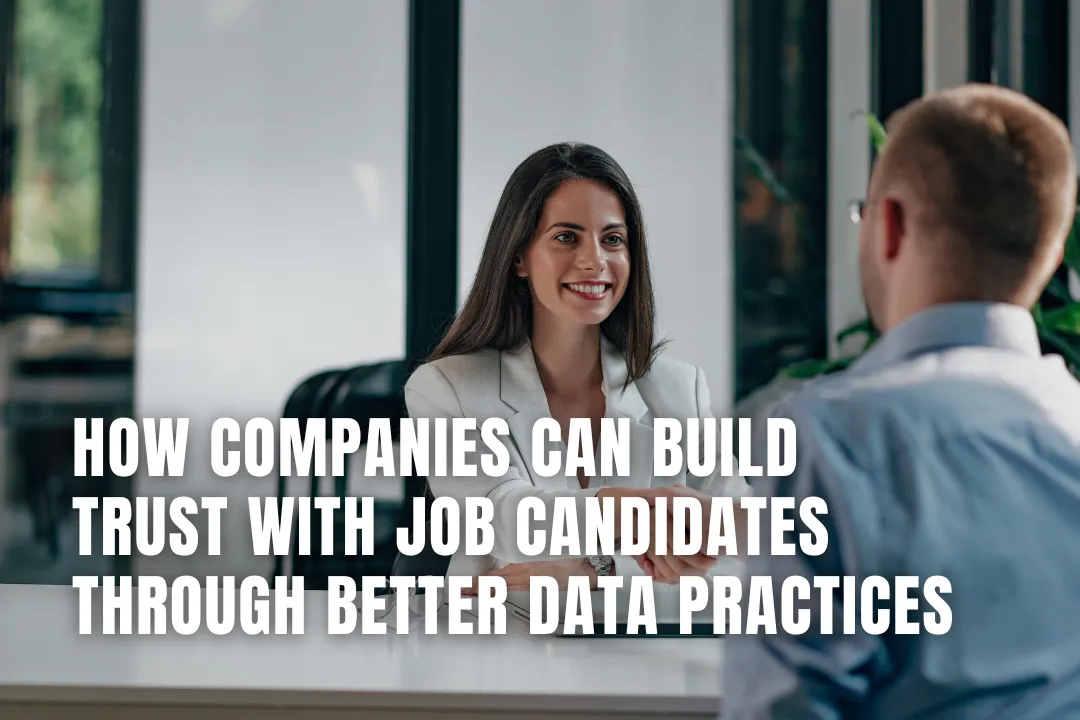
Hiring used to be about salary, perks, and a flashy office tour. In 2025, there’s something else at stake: trust.
Job candidates don’t just want a good offer; they want to know their data is safe. They’re paying attention to how you handle their personal information, from the first click on your careers page to long after the interview is over. And if you don’t have a clear, transparent approach, the best candidates will walk.
Let’s break down why trust matters more than ever, and how your hiring process can be the place where trust is earned, not lost.
Today’s candidates aren’t just applying for a job. They’re evaluating your company as a potential partner in their career, and that includes your data practices.
In fact, nearly 80% of job seekers today say they would avoid applying if they didn't trust how a company handles their data. And honestly, can you blame them?
Every time they hear about resumes or ID numbers leaked in a breach, they think twice before handing over their information. If your data practices aren’t transparent and trustworthy, the best talent will move on before you even know they were interested.
Put yourself in the candidate’s shoes: you’re ready to apply for a promising job. You upload your resume… and then you’re hit with a dozen fields asking for your ID number, exact address, salary history, and even personal health disclosures.
It doesn’t feel like an opportunity. It feels like a data grab. Candidates get especially uneasy when asked for certain types of information too soon. If your job ad looks like it’s riddled with red flags, they’ll run in the opposite direction.
Asking for detailed demographic info, government ID numbers, or health details without a good reason? That’s a red flag for most candidates.
If people don’t feel safe handing over their info, they’re not going to bother applying. Or worse, they’ll share their bad experience with others online, and your hiring process may be affected even further.
Geography and industry also play a role. A fintech developer in Berlin expects GDPR compliance as table stakes. Meanwhile, someone applying for a sales role in Texas may be less policy-savvy, but they still want to feel respected and in control.
The first real interaction a candidate has with your company is often through your job application form. This is your handshake moment, so make it count.
Your form design should feel intentional. If it looks like it hasn’t been updated in a decade, chances are prospects will consider your data practices outdated as well. So ditch the unnecessary fields, simplify copy, and keep it user-focused.
Make your privacy policy easy to find and even easier to understand. Don’t tuck it away in the footer or hide it behind vague legal jargon. If you’re asking candidates for personal information, tell them why.
Adding something as simple as “We collect this to review your application and will keep it safe for six months” can create a more trustworthy relationship.
If strong candidates aren’t making it through your ATS, the issue might be formatting, not qualifications. As a recruiter, having helpful resources ready can improve your talent pool.
When you spot an applicant with great experience who didn’t make it past the system, don’t write them off. Instead, offer a quick lifeline:
“Check my resume ATS-friendly guide, and try again!”
If you can’t write your own, point them to tools like Rezi that will make it easier. It’s a simple nudge that shows you’re on their side. And if they reapply, you’ll know they’re serious. It also signals that your company isn’t just efficient, but human.
Just because someone clicked your job ad, or even viewed your careers page, doesn’t mean you have a green light to track, store, or retarget their data indefinitely.
Interest isn’t consent.
And yet, many companies still operate under the assumption that a click equals permission. For passive candidates, that kind of tracking can feel intrusive. Especially when your ads start popping up everywhere they go online.
Running remarketing or sourcing campaigns? If so, now is a great time to rethink how you do it. Candidates are more aware of privacy than ever, which means shifting to safer, more respectful methods, like server-side tagging, is quickly becoming the smarter choice for hiring teams.
What is server-side tagging? Usercentrics has a great explainer on it, why it matters, and how it helps companies stay compliant while still capturing the data they need.

A lot of companies think of privacy as just a legal checkbox. But in recruiting, it’s so much more than that. When your process respects candidates and feels easy to navigate, people are more likely to finish applying, and even tell others good things about your company.
They accept your offers. When the opposite happens (when forms feel bloated or invasive), drop-off rates quietly spike, and your best prospects vanish. Respectful data practices reduce friction. And less friction leads to better recruiting performance, at every stage of the funnel.
Your privacy policy shouldn’t be a 40-page document no one reads. It should say things like:
Want to take it further? Give control. Let candidates decide if they want to stay in your talent pool. Make sure that opting out is just as easy as signing up. Offering them that kind of authority over their own information helps build real trust and shows that you take their privacy seriously.
Before you promise privacy to your applicants, audit your forms. Ask yourself: Do we really need this right now?
If you can’t justify collecting a field with a clear business reason, drop it. The less you gather, the safer (and faster) your process becomes.
Interviews get personal. Candidates often share private things like career breaks, health challenges, or family responsibilities. If you’re recording these conversations, make sure you tell them upfront.
They’re going to want to know:
The same goes for skills assessments. They should be treated as sensitive asset, stored securely and accessible only to relevant reviewers.
Train your hiring team to be mindful. A manager jotting down “seems anxious” or “had knee surgery last year” in shared notes could unintentionally create a liability. Focus on job-related observations, not personal ones.
After a decision is made, don’t ghost the data. Keep candidates updated on what happens next and what to expect from you. If they’re not moving forward, ask whether they’d like to stay in your database for future roles. Honour deletions. Automate it where possible.
Ensure your systems, especially ATS and HRIS platforms, handle transfers securely. Avoid Slack downloads and rogue spreadsheets. Centralise and lock down your data flows.
You can’t just preach privacy. You need the infrastructure to support it.
What does that mean?
Most companies have one for customer data. Few have one for job applicants. That’s a gap you can’t afford.
Yes, you need to follow privacy laws like GDPR, CCPA, POPIA, and LGPD. But compliance is the floor, not the ceiling.
Great companies go further:
Even third-party tools that help candidates need a close look. If you’re suggesting outside services, make sure they don’t bring hidden trackers or share data in ways you wouldn’t want. After all, what you recommend says a lot about your company.
The companies that win the hiring game won’t just be the ones offering the highest salaries or flashiest perks. They’ll be the ones who treat candidate data with the same care and intention as customer data. For job seekers, privacy is personal and non-negotiable.
From the first form field on your careers page to the way you handle post-interview feedback, every interaction sends a message. Are you a company that values people, or just data points?
Building trust doesn’t require a total tech overhaul, it starts with small, thoughtful decisions: simplifying your forms, offering real consent options, being transparent about what happens to data, and working with vendors who share your standards. It means meeting candidates where they are.
And in doing so, you do more than stay compliant. You send a powerful signal that your organisation is mature, modern, and worth joining.